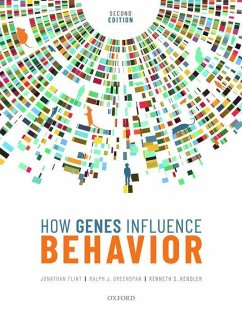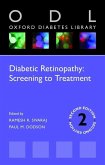Jonathan Flint (Semel Institute for Neuroscience and Human Behavior, Ralph J. Greenspan (Kavli Institute for Brain and University Mind, Kenneth S. Kendler (Virginia Institute for Psychiatric and Behavior
How Genes Influence Behavior 2e
Jonathan Flint (Semel Institute for Neuroscience and Human Behavior, Ralph J. Greenspan (Kavli Institute for Brain and University Mind, Kenneth S. Kendler (Virginia Institute for Psychiatric and Behavior
How Genes Influence Behavior 2e
- Broschiertes Buch
- Merkliste
- Auf die Merkliste
- Bewerten Bewerten
- Teilen
- Produkt teilen
- Produkterinnerung
- Produkterinnerung
How Genes Influence Behavior 2e takes a personal and lively approach to the study of behavioral genetics, providing an up-to-date and accessible introduction to a variety of approaches and their application to a wide range of disorders, and modeling a critical approach to both methods and results.
Andere Kunden interessierten sich auch für
![PARTICLE ASTROPHYSICS 2E OMSP P PARTICLE ASTROPHYSICS 2E OMSP P]() D.H. Perkins (University of Oxford Department of Physics)PARTICLE ASTROPHYSICS 2E OMSP P65,99 €
D.H. Perkins (University of Oxford Department of Physics)PARTICLE ASTROPHYSICS 2E OMSP P65,99 €![RELATIVITY GRAVIT COSMOL 2E OMSP P RELATIVITY GRAVIT COSMOL 2E OMSP P]() Ta-Pei Cheng (Department of Physics and University of Mi AstronomyRELATIVITY GRAVIT COSMOL 2E OMSP P59,99 €
Ta-Pei Cheng (Department of Physics and University of Mi AstronomyRELATIVITY GRAVIT COSMOL 2E OMSP P59,99 €![CARE OF ACUTELY ILL ADULT 2E P CARE OF ACUTELY ILL ADULT 2E P]() Spiers CreedCARE OF ACUTELY ILL ADULT 2E P62,99 €
Spiers CreedCARE OF ACUTELY ILL ADULT 2E P62,99 €![Genes Genes]() Jonathan Slack (Emeritus Professor, Emeritus Professor, UniversityGenes16,99 €
Jonathan Slack (Emeritus Professor, Emeritus Professor, UniversityGenes16,99 €![PROT INDO EUR TO PROT GERM 2E HOENG C PROT INDO EUR TO PROT GERM 2E HOENG C]() Don Ringe (Professor of Linguistics, Professor of Linguistics, UnivPROT INDO EUR TO PROT GERM 2E HOENG C129,99 €
Don Ringe (Professor of Linguistics, Professor of Linguistics, UnivPROT INDO EUR TO PROT GERM 2E HOENG C129,99 €![DIABETIC RETINOPATHY 2E ODL P DIABETIC RETINOPATHY 2E ODL P]() Dodson SivarajDIABETIC RETINOPATHY 2E ODL P67,99 €
Dodson SivarajDIABETIC RETINOPATHY 2E ODL P67,99 €![Selfish Genes to Social Beings Selfish Genes to Social Beings]() Jonathan Silvertown (Honorary Professor, Honorary Professor, InstitSelfish Genes to Social Beings26,99 €
Jonathan Silvertown (Honorary Professor, Honorary Professor, InstitSelfish Genes to Social Beings26,99 €-
-
-
How Genes Influence Behavior 2e takes a personal and lively approach to the study of behavioral genetics, providing an up-to-date and accessible introduction to a variety of approaches and their application to a wide range of disorders, and modeling a critical approach to both methods and results.
Produktdetails
- Produktdetails
- Verlag: Oxford University Press
- 2 Revised edition
- Seitenzahl: 388
- Erscheinungstermin: 23. März 2020
- Englisch
- Abmessung: 246mm x 189mm x 21mm
- Gewicht: 660g
- ISBN-13: 9780198716877
- ISBN-10: 0198716877
- Artikelnr.: 58565013
- Herstellerkennzeichnung
- Libri GmbH
- Europaallee 1
- 36244 Bad Hersfeld
- gpsr@libri.de
- Verlag: Oxford University Press
- 2 Revised edition
- Seitenzahl: 388
- Erscheinungstermin: 23. März 2020
- Englisch
- Abmessung: 246mm x 189mm x 21mm
- Gewicht: 660g
- ISBN-13: 9780198716877
- ISBN-10: 0198716877
- Artikelnr.: 58565013
- Herstellerkennzeichnung
- Libri GmbH
- Europaallee 1
- 36244 Bad Hersfeld
- gpsr@libri.de
Jonathan Flint is a Professor at the University of California Los Angeles where he works on the genetic basis of depression using both human and animal models. Ralph Greenspan is a Professor at the University of California San Diego where he is Associate Director of Kavli Institute for Mind and Brain. He work includes analysis of the genetic control of nervous system development in the fruit fly and mouse, and genetic and neurobiological studies of innate and learned behaviors in the fruit fly. Kenneth Kendler is a Professor at the Virginia Institute for Psychiatric and Behavioral Genetics at the Virginia Commonwealth University. He has conducted family and twin studies on a range of psychiatric and substance use disorders as well as molecular genetic studies on schizophrenia, alcoholism, and depression.
1: Introduction
2: The genetic epidemiology of schizophrenia
3: Molecular biology of nucleic acids
4: Epigenetics, gene regulation, and 'omic technologies
5: Linkage and association
6: Genome wide association studies (GWAS)
7: Molecular genetics of schizophrenia
8: Autism spectrum disorder
9: Intellectual disability and developmental disorders
10: Anxiety, depression, and eating disorders
11: Alcoholism
12: The genetics of intelligence, personality, and personality disorders
13: Genes for what?
14: Genes and the environment
15: Mapping mouse behavior
16: Reverse genetics
17: Mutagenesis and the molecular dissection of circadian rhythms
18: Many vs. One: Genetic Variation in Flies and Worms
19: Comparative genomics
20: How genes influence behavior
21: How do we know a finding is true? Quantitative Approaches
Appendix
2: The genetic epidemiology of schizophrenia
3: Molecular biology of nucleic acids
4: Epigenetics, gene regulation, and 'omic technologies
5: Linkage and association
6: Genome wide association studies (GWAS)
7: Molecular genetics of schizophrenia
8: Autism spectrum disorder
9: Intellectual disability and developmental disorders
10: Anxiety, depression, and eating disorders
11: Alcoholism
12: The genetics of intelligence, personality, and personality disorders
13: Genes for what?
14: Genes and the environment
15: Mapping mouse behavior
16: Reverse genetics
17: Mutagenesis and the molecular dissection of circadian rhythms
18: Many vs. One: Genetic Variation in Flies and Worms
19: Comparative genomics
20: How genes influence behavior
21: How do we know a finding is true? Quantitative Approaches
Appendix
1: Introduction
2: The genetic epidemiology of schizophrenia
3: Molecular biology of nucleic acids
4: Epigenetics, gene regulation, and 'omic technologies
5: Linkage and association
6: Genome wide association studies (GWAS)
7: Molecular genetics of schizophrenia
8: Autism spectrum disorder
9: Intellectual disability and developmental disorders
10: Anxiety, depression, and eating disorders
11: Alcoholism
12: The genetics of intelligence, personality, and personality disorders
13: Genes for what?
14: Genes and the environment
15: Mapping mouse behavior
16: Reverse genetics
17: Mutagenesis and the molecular dissection of circadian rhythms
18: Many vs. One: Genetic Variation in Flies and Worms
19: Comparative genomics
20: How genes influence behavior
21: How do we know a finding is true? Quantitative Approaches
Appendix
2: The genetic epidemiology of schizophrenia
3: Molecular biology of nucleic acids
4: Epigenetics, gene regulation, and 'omic technologies
5: Linkage and association
6: Genome wide association studies (GWAS)
7: Molecular genetics of schizophrenia
8: Autism spectrum disorder
9: Intellectual disability and developmental disorders
10: Anxiety, depression, and eating disorders
11: Alcoholism
12: The genetics of intelligence, personality, and personality disorders
13: Genes for what?
14: Genes and the environment
15: Mapping mouse behavior
16: Reverse genetics
17: Mutagenesis and the molecular dissection of circadian rhythms
18: Many vs. One: Genetic Variation in Flies and Worms
19: Comparative genomics
20: How genes influence behavior
21: How do we know a finding is true? Quantitative Approaches
Appendix









